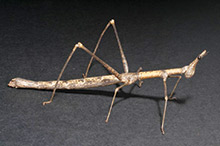
The researchers analyzed the middle legs and the enlarged hind legs of the horsehead grasshopper, which are used to propel the insect into the air when it jumps. The femur-tibia joints (“knee” joints) are clearly visible in all the legs. Photograph courtesy of ©Tom Matheson.
Neurobiologists from the University of Leicester, England, have shown that insect limbs can move without muscles, a finding that they say may provide engineers with new ways to improve the control of robotic and prosthetic limbs. Their work helps to explain how insects control their movements using a close interplay of neuronal control and “clever biomechanical tricks,” said lead researcher Tom Matheson, PhD, a Reader in neurobiology at the University of Leicester.
In a study, which was published July 18 online ahead of print in the journal Current Biology, the researchers show that the structure of some insect leg joints causes the legs to move even in the absence of muscles. So-called “passive joint forces” return the limb back toward a preferred resting position. The passive movements differ in limbs that have different behavioral roles and different musculature, suggesting that the joint structures are specifically adapted to complement muscle forces. For example, the passive movements are stronger where they assist the weaker of two antagonistic muscles. The researchers propose a motor-control scheme for insect limb joints in which not all movements are driven by muscles.
“In the locust hind leg, which is specialized for jumping and kicking, the extensor muscle is much larger and stronger than the antagonist flexor muscle,” Matheson explained. “This enables the animal to generate powerful kicks and jumps propelled by extensions of the tibia that are driven by contractions of the extensor muscle. When locusts prepare to jump, large amounts of energy generated by the extensor muscle are stored in the muscle’s tendon and in the hard exoskeleton of the leg.
“Surprisingly, we noticed that when the muscles were removed, the tibia naturally flexed back towards a midpoint, and we hypothesized that these passive-return movements might be counterbalancing the strong extensor muscle.”
To test this hypothesis, the researchers looked at the literature and examined other legs where the extensor and flexor muscles are more closely balanced in size or strength, or where the flexor is stronger than the extensor.
“We found that the passive joint forces really do counterbalance the stronger of the flexor or extensor muscle in the animals and legs we looked at,” said Jan M. Ache, a master’s student from the Department of Animal Physiology at the University of Cologne, Germany, who worked in Matheson’s lab and is the first author on the paper. “In the horsehead grasshopper, for example, passive joint forces even differ between the middle legs (which are primarily used for walking) and the hind legs (which are adapted for jumping), even in the same individual animal. In both pairs of legs, the passive joint forces…enable a transfer of energy from the stronger to the weaker muscle.”
Using balanced passive forces may provide engineers with new ways to improve the control of robotic and prosthetic limbs, the researchers said.
“We hope that our work on locusts and grasshoppers will spur a new understanding of how limbs work and can be controlled, by not just insects, but by other animals, people, and even by robots,” Matheson said.
Editor’s note: This story was adapted from materials provided by the University of Leicester.




